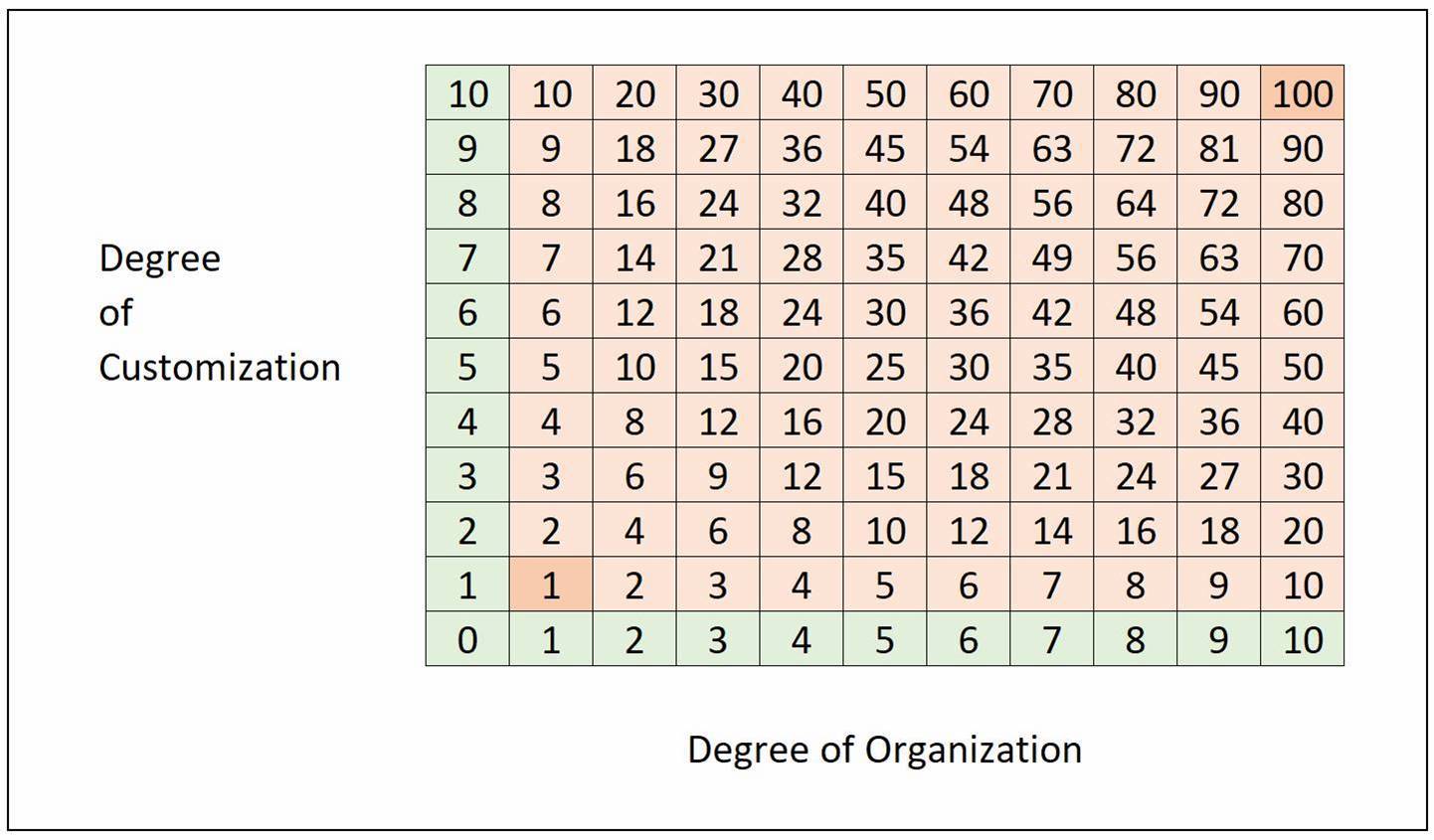ERP Implementation Challenges
Bridging functionality gaps in ERP is one of the great challenges in an Epicor implementation, or of any enterprise resource planning project. There are often visible gaps between a company’s business requirements and the system’s ability to address them. In a perfect world, the needs of the company perfectly match the capabilities of the system they are implementing. In practice, the gaps between an organization and its ERP application can be significant, and closing these gaps can take significant effort. The inability to successfully close these gaps is a leading cause of project failure. This guide will help you understand a few ERP implementation best practices to help address the great challenge of closing the gaps.

ERP Customization
- Find creative ways to use the system’s standard configurations to address the needs of your business.
- Adjust your business processes to conform to the system’s recommended best practices.
- Tailor the software in one form or another to provide needed functionality.
- Combine the above methods to achieve a hybrid solution.
So why do businesses feel the need to tailor the applications they implement? ERP software customization is a means of closing gaps. Sometimes, it is the preferred means of addressing challenges before they start. Often, gap closure will involve some form of customization. The overall level of ERP project complexity will expand with increasing challenges and risks. In general, the different types of obstacles encountered in an ERP project can be grouped under one of a few headings. Customizing an ERP application allows you to do a number of things and to circumvent a number of issues:
- Automate tasks. The standard system is too transactional and user-intensive.
- Prevent errors. The standard system allows for too many points of failure as a function of user entry.
- Integrate with third-party systems. The standard system does not provide specific functionality, necessitating a tertiary application. Similarly, the standard system does not integrate with the third-party module in question.
- Extract and display data. The standard system’s out-of-the-box reports do not present the necessary information needed by the business.
- Add business logic. The standard system does not possess logic needed by the implementing company.
The Total Cost of Ownership of an ERP Solution
The rule of thumb that came out of the first generation of ERP systems was simple: avoid customizing the ERP system at all costs. Fit the business to the software, not the software to the business. Considering the comparatively rigid systems of the era, this recommendation seemed valid. Earlier-generation ERP systems contained limited toolsets for tailoring the application to meet the needs of the implementing organization. As such, customization essentially implied a source code modification, and such changes were detrimental to the long-term maintainability of the systems involved.
ERP Implementation Best Practices Evolving
Next-generation ERP systems contained improved toolsets to provide non-source-code customizations that were upgradable and maintainable, but the disruptive effects of customization on the implementation projects nevertheless continued unabated. Why do ERP customizations continue to create challenges to organizations?
Customizations are disruptive—they introduce logic to the application that is not native to the core system. They may also behave in ways that are unlike the rest of the system, and tend to be less comprehensive than the source code that they are layered upon.
As they are developed and refined, they often contain bugs. For example, the custom business logic may be invoked at times when it isn’t expected, or may not be invoked in all cases that require it. Working though these bugs can be challenging. Moreover, when customizations run into bugs or undocumented features of the core application, an abundance of unexpected behaviors can result.
ERP Toolsets & Project Success
Everything said, how do companies successfully leverage the customization toolsets available? How do they provide the necessary functionality to their organizations without compromising project success? Consider the following observations:
- On one hand, we’ve seen companies significantly customize their application in an organized and methodical fashion. Therefore, the customizations produced a limited disruption to the implementation.
- On the other hand, we’ve encountered other companies that only modestly customized their application. The modest number of customizations significantly disrupted the implementation. Why?
Organize to Optimize Your ERP Software
The level of customization and the level of organization of a project are closely tied. Therefore, companies that organize their customization efforts carefully are much less likely to experience problems caused by customizations. Conversely, poorly organized customization efforts will create additional issues that will add complexity and disruption to an implementation that is already, by its very nature, complicated.
Quantifying the impact of these two variables (customization and organization) can be difficult, but a simple mathematical model might help to model their interaction.
- Assume that a project’s level of disorganization can be scored on a scale from 1 to 10, with 1 being highly organized and 10 being highly disorganized.
- Similarly, assume that a project’s level of customization can be scored on a scale from 1 to 10, with 1 being lightly customized and 10 being highly customized.
- Additionally, assume that a project’s success can be scored on a scale of 1 to 100, and anything over a score of 20 is a bad thing. For example, the project could be over budget, behind schedule, or low in scope or quality. In this context, a score of 30 might imply a project that went live late, or had to cut scope, or exceeded the budget, while a ruination score of 100 might represent a project that is years late, millions over budget, and so poorly designed that it will fail to go live.
A score of 1 (very low customization, very low disorganization) represents a very low risk score and a score of 100 (very high customization, very high disorganization) represents immense and catastrophic risk to your ERP and to your business:

The simple lesson to be learned here is that an organization can perform reasonable amounts of customization to their ERP application without destroying an implementation. A company needs to take steps to utilize an organized approach to customizing their application.
ERP Risks
A challenge with this dilemma is the reality that most companies do not launch an ERP implementation project believing that they will customize the application significantly. As a result, when these change requests surface, they are normally ill-equipped to handle them, and things soon spin out of control. As such, many customers come to us asking the simple question: What does it mean when one’s customization methodology is highly organized?
ERP Project Risk Management
There are a number of characteristics that an organized implementation possesses. They include the following:
- First and foremost, governance is in place, to control when customizations occur. Governance is the best way to keep the degree of customization from spinning out of control.
- Solutions are tracked. The implementing company understands which modules have been customized and which reports have been altered. They have identified all truly custom entry screens, reports, and dashboards. This information is put to use whenever an ERP upgrade occurs or a new site goes live.
- Business requirements and functional specifications are developed as solutions are developed, and these solutions are constructed using these specifications.
- Guidelines are defined ahead of time. These are conventions that describe how custom solutions are to be constructed, organized, and named.
- Solutions go through careful testing. They receive a unit test to ensure that the basic requirements have been met, and then a regression test, to ensure that they function appropriately within the overall application, and don’t break anything else.
- Solutions go through careful deployments to the production environment. When old solutions replace new solutions, the old solutions are removed from the environment as part of the deployment, to prevent the environment from getting cluttered with old, inactive solutions.
- When an ERP module is customized, the developers take into account the full suite of new and pre-existing customizations, as to ensure that new elements are optimized to efficiently work in concert with existing custom solutions.
- Environments are constructed as to segment various activities such as functional design, custom solution development, and upgrade verification. When these activities overlap, conflicts invariably arise, and these can slow down the progress of a project and create needless confusion.
The Goal of an ERP Implementation is Twofold
How do you implement a system that satisfies the needs of your business? How do you stay scalable and maintainable and also support the future requirements of your organization?
The future of your business is always unknown, and often unpredictable. Therefore, cutover will surely present new unknowns. Heavy system customization often results in the achievement of the goals of business needs. Unfortunately, this can risk the long-term maintainability of your ERP system. An organized and methodical approach to system customization supports a more successful implementation. Moreover, it provides easier long-term maintenance of your application. Likewise, it holds the ability to support the business requirements of the future.
After the ERP Vendor, the Software
Are you trying to improve your manufacturing processes? Do you need user training to empower your ERP project team? Are you looking for the competitive advantage that cloud ERP offers? Do you need help with data migration to an ERP hosting environment for a complex enterprise resource planning software like Prophet 21, E10, or Sage? We have experts for everything ERP, whether you need Epicor consulting assistance or QuickBooks hosting guidance.
For 17 years, EstesGroup has served clients at every step of the ERP implementation process. We offer real-time support 24/7/365 for your implementation team. We optimize your technology, and we lighten the burden on the precious human resources that make your company unique. Your team can work according to their talents, while we do the routine work involved in managing your ERP software and the technology that supports it.
Learn More About ERP Implementation Best Practices for Cloud
A good ERP balances your budget, opens your resources to new possibilities and opportunities, and improves everything from customer relationship management to industry-specific compliance and cybersecurity. ERP cloud hosting provides an ideal platform for your work. Request an ECHO demo today to see how EstesCloud managed services can help your business.

